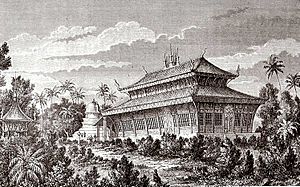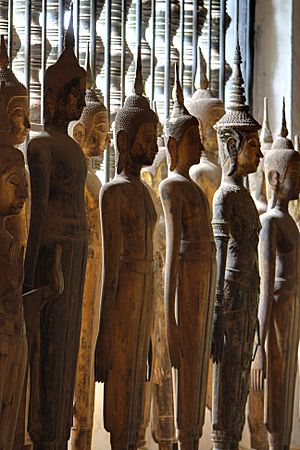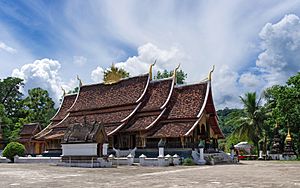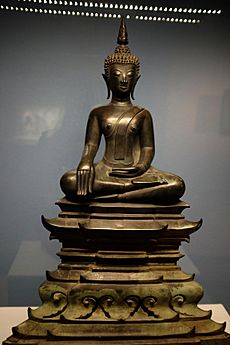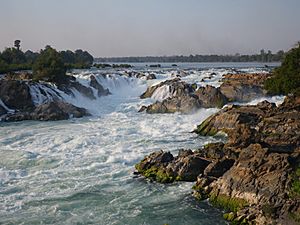Lan Xang facts for kids
Quick facts for kids
Kingdom of Lan Xang
ອານາຈັກລ້ານຊ້າງ
|
|||||||||||||||||
|---|---|---|---|---|---|---|---|---|---|---|---|---|---|---|---|---|---|
| 1353–1707 | |||||||||||||||||

Kingdom of Lan Xang (green) in 1400 CE
|
|||||||||||||||||
| Capital | Luang Prabang (1353–1560) Vientiane (1560–1707) |
||||||||||||||||
| Common languages | Lao | ||||||||||||||||
| Religion | Theravada Buddhism | ||||||||||||||||
| Government | Absolute monarchy | ||||||||||||||||
| King | |||||||||||||||||
|
• 1353–1385
|
Fa Ngum | ||||||||||||||||
|
• 1373–1416
|
Samsenethai | ||||||||||||||||
|
• 1548–1571
|
Setthathirath | ||||||||||||||||
| Historical era | Middle Ages and Renaissance | ||||||||||||||||
|
• Founded by Fa Ngum
|
1353 | ||||||||||||||||
|
• Kingdom partitioned
|
1707 | ||||||||||||||||
| Currency | Lat, Hoi | ||||||||||||||||
|
|||||||||||||||||
The Lao Kingdom of Lan Xang Hom Khao (Lao: ລ້ານຊ້າງຮົ່ມຂາວ lān sāng hôm khāo) means "Million Elephants and White Parasols". This powerful kingdom existed as a united country from 1353 to 1707.
For over 350 years, Lan Xang was one of the biggest kingdoms in Southeast Asia. Its name showed the king's power and the strong army it had. This kingdom is the ancestor of modern-day Laos. It forms the basis for Laos' history and culture.
Contents
- Discovering Lan Xang's Past
- How Lan Xang Began
- The Story of Khun Borom
- King Fa Ngum's Conquests
- King Samsenthai and Queen Maha Devi's Influence
- The White Elephant War with Đại Việt
- King Visoun and a Flourishing of Culture
- Lanna and War with Ayutthaya
- King Setthathirath and the Burmese Invasions
- Lan Xang Becomes Strong Again
- The Golden Age of Lan Xang
- The Kingdom Splits Apart
- How Lan Xang Was Organized
- Life in Lan Xang Society
- Religion and Beliefs
- Lan Xang's Economy
- Why Lan Xang Declined
- See also
Discovering Lan Xang's Past
How Lan Xang Began
The land where Lan Xang grew was first home to ancient tribes. These tribes created early cultures like the Bronze Age cultures in Ban Chiang. Later, Tai peoples moved south into this area. This happened from the 7th century onwards. More Tai people arrived after the Mongol conquest of Yunnan in the 1200s.
The northern Mekong River valleys were first settled by the Mon people. Later, the Khmer Empire ruled there. The main city in the north was called Muang Sua. Today, this city is known as Luang Prabang.
As the Sukhothai Kingdom grew, cities like Vientiane and Luang Prabang came under Tai influence. After the Sukhothai king died, these cities became independent. Then, in 1353, the Kingdom of Lan Xang was founded.
The Story of Khun Borom
The people of Lan Xang had special stories about their origins. These stories helped them remember how different groups came together. The Nithan Khun Borum or "Story of Khun Borom" was very important. It told how the kings of Lan Xang were connected to a legendary king named Khun Lo. This made their rule seem rightful and strong.
King Fa Ngum's Conquests
The history of Lan Xang officially starts in 1316 with the birth of Fa Ngum. His grandfather was the king of Muang Sua. Fa Ngum grew up in the Khmer Empire. In 1349, he was given an army to claim the throne.
The Khmer Empire was getting weaker at this time. Other kingdoms like Lanna and Sukhothai were growing. This was a chance for the Khmer to create a friendly kingdom in an area they couldn't control well.
Fa Ngum started his campaign in southern Laos. He took towns along the middle Mekong River. He then moved north. Muang Phuan helped him, and he quickly took that area. He also took some towns from Đại Việt (modern-day Vietnam).
The Vietnamese kingdom of Đại Việt wanted clear borders. They agreed to use the Annamite Range as a natural border. Fa Ngum then moved to take Muang Sua. After three attacks, the King of Muang Sua, who was Fa Ngum's uncle, took his own life.
In 1353, Fa Ngum was crowned king. He named his kingdom Lan Xang Hom Khao, meaning "The Land of a Million Elephants and the White Parasol." He continued to expand his kingdom. He took areas near the Mekong River and even defeated Lanna.
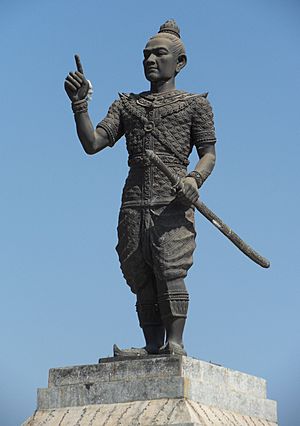
In 1356, Fa Ngum marched south to take Vientiane. He took Vientiane in 1357. He then moved further south, taking cities on the Khorat Plateau. He went as far as Roi Et.
The King of Ayutthaya recognized Lan Xang's control over the Khorat Plateau. He sent gifts and even offered his daughter, Nang Keo Lot Fa, to be Fa Ngum's wife. By 1357, Fa Ngum had created a huge kingdom. It stretched from China in the north to Khong Island in the south. It was one of the largest kingdoms in Southeast Asia.
King Samsenthai and Queen Maha Devi's Influence
In the 1360s, Lan Xang fought against Sukhothai. Lan Xang won, but the people were tired of war. Fa Ngum was removed from power. His son, Oun Huean, became king. Fa Ngum went into exile and died later.
In 1371, Oun Huean was crowned King Samsenethai. His name meant "King of 300,000 Tai people." This showed he favored the Lao-Tai population. Samsenthai made his father's gains stronger. He also fought back Lanna in the 1390s. In 1402, China's Ming Empire officially recognized Lan Xang.

Teal: Lan Xang
Purple: Lan Na
Orange: Sukhothai Kingdom
Blue Violet: Ayutthaya Kingdom
Red: Khmer Empire
Yellow: Champa
Blue: Đại Việt
Samsenthai died in 1416 at age sixty. His son, Lan Kham Deng, became king. During his reign, the Vietnamese asked Lan Xang for help against the Ming. Lan Xang sent an army, but they sided with the Chinese instead.
After Lan Kham Deng died, there was a period of trouble. From 1428 to 1440, seven kings ruled Lan Xang. All of them were killed due to power struggles. A queen known as Maha Devi or Nang Keo Phimpha (The Cruel) was behind these events. She might have ruled Lan Xang herself from 1440 to 1442. She was killed in the Mekong River in 1442. Even with this trouble, the capital at Muang Sua managed to control a rebellion in Vientiane. A new king, Chakkaphat, was crowned in 1456.
The White Elephant War with Đại Việt
In 1448, during the time of trouble, Muang Phuan was taken by Đại Việt. In 1471, the Vietnamese destroyed the kingdom of Champa. Also in 1471, Muang Phuan rebelled against Vietnam. Many Vietnamese were killed. By 1478, Vietnam was preparing a large invasion of Lan Xang. This was to get revenge for the rebellion and for Lan Xang helping the Ming in 1421.
Around this time, a white elephant was captured for King Chakkaphat. White elephants were symbols of kingship. The Vietnamese emperor asked for the elephant's hair as a gift. This was seen as an insult. Legend says a box of dung was sent instead.
A huge Vietnamese army of 180,000 men invaded. Lan Xang met them with 200,000 soldiers and 2,000 elephant cavalry. The Vietnamese won a tough battle. They continued north and took the capital of Luang Prabang. King Chakkaphat and his court fled south to Vientiane.
The Vietnamese split their forces. One group went west, threatening Lanna. Another went south along the Mekong River toward Vientiane. King Tilok of Lanna destroyed the northern Vietnamese army. The forces around Vientiane rallied under King Chakkaphat's son, Prince Thaen Kham. They destroyed the Vietnamese forces, who retreated.
Prince Thaen Kham offered the throne back to his father. But King Chakkaphat refused. His son was crowned as Suvanna Balang in 1479. The Vietnamese did not invade Lan Xang for the next 200 years. Lanna became a close friend to Lan Xang.
King Visoun and a Flourishing of Culture
Under later kings, Lan Xang recovered from the war. This led to a time of great culture and trade. King Visoun (1500–1520) supported the arts. During his rule, the classic literature of Lan Xang was first written down. Theravada Buddhist monks and monasteries became centers of learning.
Important stories like the Nithan Khun Borom were written. Also, the Jataka Tales (stories about the Buddha's past lives) were recorded. The Tripitaka (Buddhist scriptures) was translated into Lao. The Lao version of the Ramayana, called Pra Lak Pra Lam, was also written.
Epic poems, medical books, and law books were created. Lao court music also became more organized. King Visoun built many important temples. He chose the Phra Bang Buddha image as a special protector for Lan Xang. This image was believed to have come from Sri Lanka. It was so important that the capital city was renamed Luang Prabang in its honor.
King Visoun, his son Photisarath, his grandson Setthathirath, and his great-grandson Nokeo Koumane were strong leaders. They kept the kingdom safe despite many challenges.
Lanna and War with Ayutthaya
King Photisarath (1520–1550) was a great king of Lan Xang. He married queens from Lanna, Ayutthaya, and Longvek. Photisarath was a strong Buddhist. He made Buddhism the official religion of Lan Xang. In 1527, he stopped the practice of spirit worship throughout the kingdom.
In 1533, he moved his court to Vientiane. Vientiane was the main city for trade. It was easier to defend and to manage the kingdom from there. In 1539, Photisarath improved That Phanom to strengthen Lan Xang's power in the south.
In 1539, a Thai noble sought safety in Lan Xang after a failed rebellion in Ayutthaya. This led to Ayutthaya invading Lan Xang. But Lan Xang won the battle in 1540.
Lanna had many internal problems in the 1540s. It was invaded by Burma and then by Ayutthaya. Lan Xang sent help to Lanna. In 1547, Ayutthaya's King Chairacha tried to take Chiang Mai but was defeated.
Because of Lan Xang's help, King Photisarath's son, Prince Setthathirath, was offered the throne of Lanna. In 1547, he was crowned King in Chiang Mai. Lan Xang was very powerful at this time. Setthathirath took the Emerald Buddha as his personal protector.
The peace did not last. In 1548, the Burmese invaded Ayutthaya. In 1550, King Photisarath died in an elephant accident.
King Setthathirath and the Burmese Invasions
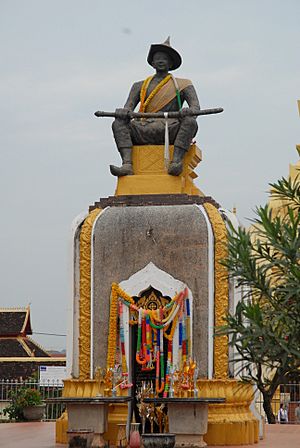
In 1548, King Setthathirath had made Chiang Saen his capital in Lanna. After his father's death, King Setthathirath left Lanna to become King of Lan Xang. His departure allowed rival groups in Lanna to crown a new king.
In 1553, King Setthathirath tried to retake Lanna but failed. In 1556, Burma invaded Lanna. Lanna's king surrendered without a fight.
In 1560, King Setthathirath officially moved the capital of Lan Xang from Luang Prabang to Vientiane. Vientiane remained the capital for the next 250 years. He built strong city defenses and a grand palace. He also built the Haw Phra Kaew to house the Emerald Buddha. Major repairs were made to That Luang in Vientiane. In Luang Prabang, Wat Xieng Thong was built.
In 1563, Lan Xang and Ayutthaya signed a peace treaty. But a disagreement over a marriage led to problems. In 1564, the Burmese invaded Ayutthaya. Ayutthaya's king lost his northern lands and his daughter. He became a vassal of Burma.
The Burmese then turned north to Lanna. Many people from Lanna fled to Vientiane. King Setthathirath knew Vientiane could not hold against a long siege. He ordered the city to be emptied of people and supplies. When the Burmese took Vientiane, they found no food. King Setthathirath used guerrilla attacks to bother them. Facing sickness and hunger, the Burmese had to retreat in 1565. Lan Xang was the only independent Tai kingdom left.
Secret Plans and More Wars
In 1567, Ayutthaya asked King Setthathirath for help to rebel against Burma. They planned a joint attack. The plan was discovered, and Burma sent more soldiers. King Setthathirath had to retreat. On his way back, he set a trap and killed five Burmese generals.
King Bayinnaung of Burma sent a huge invasion in 1568. In 1569, Ayutthaya was under attack. Vientiane sent help. The Burmese had planned for this. King Setthathirath fell into a trap. His forces were divided and destroyed. He had to retreat to Vientiane.
The Burmese took Ayutthaya. King Setthathirath ordered Vientiane to be evacuated again. The Burmese took the empty city. Setthathirath started a guerrilla campaign from his base. In 1570, Bayinnaung retreated. Setthathirath attacked and captured many Burmese soldiers and elephants.
By 1571, Ayutthaya and Lanna were under Burmese control. King Setthathirath had defended Lan Xang twice. He then moved south to fight the Khmer Empire. Winning against the Khmer would give Lan Xang access to the sea and European weapons. The Khmer records say Lan Xang invaded in 1571 and 1572. During the second invasion, King Setthathirath went missing in battle.
Setthathirath's general, Sen Soulintha, returned to Vientiane. A civil war started over who would be king. In 1573, Sen Soulintha became king, but he lacked support. The Burmese king demanded Lan Xang surrender. Sen Soulintha had the Burmese messengers killed.
Bayinnaung invaded Vientiane in 1574. Sen Soulintha ordered the city to be evacuated, but people did not support him. Vientiane fell to the Burmese. Sen Soulintha and Setthathirath's son, Prince Nokeo Koumane, were taken to Burma. A Burmese ruler was left in Vientiane. From 1583 to 1591, a civil war happened in Lan Xang.
Lan Xang Becomes Strong Again
Prince Nokeo Koumane had been held in Burma for sixteen years. In 1591, he was about twenty years old. The Buddhist clergy in Lan Xang asked for him to be returned. In 1591, he was crowned in Vientiane. He gathered an army and reunited Luang Prabang and other areas. He declared Lan Xang independent from Burma.
In 1593, King Nokeo Koumane attacked Lanna. Lanna asked Burma for help, but Burma had its own rebellions. Lanna then asked Ayutthaya for help. Ayutthaya sent a large army. King Nokeo Koumane realized he was outnumbered and called off the attack. In 1596, King Nokeo Koumane died suddenly without a child. Although he had united Lan Xang, a period of weak kings followed until 1637.
The Golden Age of Lan Xang
Under King Sourigna Vongsa (1637–1694), Lan Xang had 57 years of peace and growth. During this time, the Buddhist clergy was very powerful. Monks and nuns came from all over Southeast Asia to study. Literature, art, music, and dance all thrived. King Sourigna Vongsa updated many laws and set up courts. He also made treaties with neighboring kingdoms for trade and borders.
In 1641, the Dutch East India Company made trade contacts with Lan Xang. A Jesuit missionary, Father Giovanni Maria Leria, arrived in 1642. He described the royal palace in Vientiane:
The royal palace, which is wonderfully built, can be seen from far away. It is truly huge, so big you might think it's a city. The king's rooms are beautiful, made of strong wood (teak), and decorated with amazing gold carvings. Inside the palace, there are many houses for the king's wives and court officials. I could write a whole book trying to describe all the palace's riches, rooms, and gardens.
– Fr. Giovanni Maria Leria, (1663)
This palace and the city of Vientiane were completely destroyed by the Thai in 1827–28.
The Kingdom Splits Apart
King Sourigna Vongsa's laws applied to everyone. When he died in 1694, he left two young grandsons and two daughters. A fight for the throne began. The king's nephew, Prince Sai Ong Hue, became king. Sourigna Vongsa's grandsons fled. In 1705, one grandson, Prince Kingkitsarat, took an army and marched to Luang Prabang. He was crowned as a rival king.
In 1707, Lan Xang split into two kingdoms: Luang Prabang and Vientiane. In 1713, the Kingdom of Champasak also formed after a rebellion.
These Lao kingdoms stayed independent until 1779. Then, they became vassals to Siam (Thailand). However, they kept their own kings and some control.
How Lan Xang Was Organized
The Mekong River was like the main road for Lan Xang. It helped people, goods, and armies move around. But it also created natural defenses. Big rapids in the river formed borders between the areas that later became the kingdoms of Luang Prabang, Vientiane, and Champasak. The Khone Falls were not passable by boat. This protected Lan Xang from invasions coming upriver.
The main cities of Lan Xang were in Luang Prabang, Vientiane, and Champasak. These cities were called "muang" or "vieng." They had strong walls. The Lao records mention five other supporting cities and 97 border towns.
These cities were like independent city-states. They were connected to the king in a system called a mandala. Each city had a lord. This system was about controlling resources and people, not just land. Wars often involved moving people to new areas for taxes or work. Paying tribute to more than one powerful kingdom was also common.
Life in Lan Xang Society
Lan Xang had many different ethnic groups. These included the Lao Theung and Lao Sung hill tribes. The Lao Loum were the main ethnic group. Other related Tai groups also lived there.
Lao society was quite simple compared to its neighbors. At the top was the royal family. Then came the nobles. Below them were the common people: merchants, artists, farmers, and workers. Outside this system, but highly respected, were the Buddhist monks (the Sangha). Becoming a monk offered a way to get an education and move up in society.
The hill peoples were outside this main social system. There were also kha or "prisoners." These were people captured in war or working to pay off debts. Most traveling merchants were from Siam, Khmer, or Shan. There were also small groups of Chinese and Vietnamese in major trading cities.
Religion and Beliefs

Theravada Buddhism became the official religion of Lan Xang in 1527. But it had been growing in importance since Fa Ngum's time. Daily life in villages and towns often centered around the local temple or wat. Temples were places of learning. All males were expected to spend some time as a monk or novice. Kings showed their power by supporting the monks and building new temples.
Lan Xang had several powerful Buddha images. These were seen as protectors and spiritual symbols of the kingdom. They included the Phra Bang and the Emerald Buddha.
Animism was also a very old and important belief system for the Lao-Tai groups. It is still a part of Lao spirituality today. The Lao Loum believed in mythical serpents called ngueak. These spirits lived in major waterways. They were believed to bring rain and protect cities like Vientiane and Luang Prabang. Nāga are still seen in Lao temples and silk designs.
The natural world was also home to many spirits called Phi. These spirits could be guardians of places or ancestors. They could also be harmful. Phi were believed to affect human health. The Baci ceremony became important for spiritual well-being. Spirit houses were built to keep balance with the spirit world. Astrology was also used to understand the world and guide customs.
Lan Xang's Economy
Lan Xang was a hub for trade routes in Southeast Asia. In the north, trade from Burma and Lanna passed through Lan Xang to China. Trade in Luang Prabang flowed down the Mekong River to Vientiane. From there, goods could go overland to other rivers or across the Khorat Plateau.
In the east, the Annamite Range was a barrier. But Muang Phuan and Xam Neua were regular trade points with Vietnam. Trade from Thakhek and Champasak flowed down the Mekong River. Lao merchants traveled to hill tribe areas to trade cloth, iron, and silver for forest products.
The main crops were glutinous rice and timber. These were hard to transport. Forest products were easier to move and worth more. These included elephants, ivory, benzoin resin, lac, cardamom, beeswax, rhinoceros horn, and animal skins. Deer skin was very popular in China and Japan.
Lao crafts like silk, weaving, gold, and silver were in high demand. Villages often specialized in one craft. Iron was mined in Muang Phuan. Tin and gems were found in the north of Luang Prabang.
Luang Prabang was the religious and royal capital. But Vientiane was the largest city and the political capital from 1560. It was very important for trade. Vientiane was originally a Mon city called Chandapuri. The Lao changed its name to Vieng Chanthaburi Sisattanak, meaning "Walled City of Sandalwood and a Million Nagas."
Why Lan Xang Declined
The Lao people developed a unique culture and history during Lan Xang's 400 years. The Lao monarchy continued until 1975. However, Lan Xang's decline was due to several reasons. These included its geography, weak political structures, limited farming, and lack of access to international weapons trade.
Lan Xang was landlocked. The Mekong River was important, but only parts of it were easy to travel on. Lan Xang was surrounded by powerful neighbors like China, Burma, Ayutthaya, and Vietnam.
Politically, the kingdom had a feudal system. Local lords and nobles had a lot of power. The choice of kings was not always based on who was born first. A council of royal family members, ministers, and generals, along with the Buddhist clergy, would choose the next king. This often led to disagreements and instability.
Lan Xang's economy relied on high-value goods that were easy to transport. Rice was too heavy. The narrow valleys and climate were only good for certain types of glutinous rice. This rice gave lower yields than the rice grown in Thailand. Thailand benefited greatly from the international rice trade.
Lan Xang's goods had to pass through other kingdoms to reach world markets. So, when demand for forest products grew, Thailand often benefited more. Sea trade routes became more important than the overland routes Lan Xang used. Europeans started trading weapons with Ayutthaya as early as 1511. But the first European trade mission to Lan Xang was not until the 1640s. Access to advanced European weapons became very important in wars.
See also
 In Spanish: Lan Xang para niños
In Spanish: Lan Xang para niños



